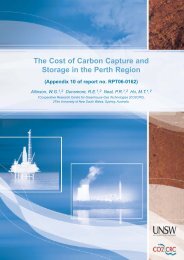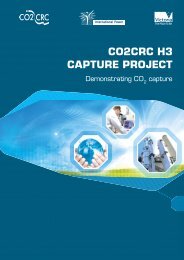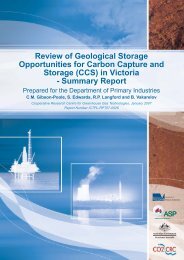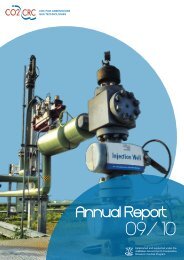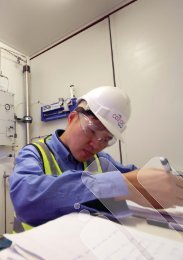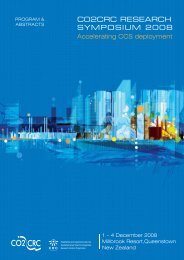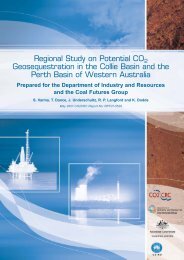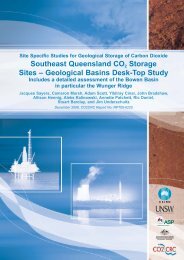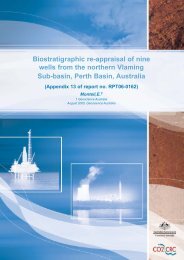Post-combustion capture of carbon dioxide - CO2CRC
Post-combustion capture of carbon dioxide - CO2CRC
Post-combustion capture of carbon dioxide - CO2CRC
Create successful ePaper yourself
Turn your PDF publications into a flip-book with our unique Google optimized e-Paper software.
<strong>Post</strong>-<strong>combustion</strong> <strong>capture</strong> <strong>of</strong><br />
<strong>carbon</strong> <strong>dioxide</strong><br />
Adsorption technologies<br />
Adsorbent <strong>capture</strong> technologies for separating <strong>carbon</strong> <strong>dioxide</strong> (CO 2<br />
) from industrial gas streams have<br />
the potential to be highly cost-effective, as they require less energy and could have less impact on the<br />
environment.<br />
Adsorbents are solids, typically minerals called zeolites, that can <strong>capture</strong> CO 2<br />
on their surface, release<br />
the CO 2<br />
following a change in temperature or pressure and be reused in a cyclical process.<br />
In current <strong>CO2CRC</strong> trials, the CO 2<br />
is released from the adsorption material by reducing the pressure.<br />
This is known as Pressure Swing Adsorption (PSA) or, where the pressure is reduced to very low<br />
pressure, Vacuum Swing Adsorption (VSA). This process is widely used in air separation, natural gas<br />
purification and hydrogen gas generation.<br />
Remove<br />
other gases<br />
Decrease pressure<br />
or increase<br />
temperature<br />
Adsorb CO 2<br />
Process<br />
stream<br />
containing<br />
CO 2<br />
to desorb CO 2<br />
Remove<br />
CO 2 -rich gas<br />
to desorb CO 2<br />
Other gases<br />
Carbon <strong>dioxide</strong> (CO 2 )<br />
Other gases<br />
Principles <strong>of</strong> adsorption.<br />
reducing <strong>carbon</strong> <strong>dioxide</strong> emissions to the atmosphere<br />
www.co2crc.com.au
<strong>Post</strong>-<strong>combustion</strong> <strong>capture</strong> <strong>of</strong><br />
<strong>carbon</strong> <strong>dioxide</strong><br />
In current <strong>CO2CRC</strong> trials, the adsorber column contains multiple layers to deal with the complex<br />
composition <strong>of</strong> the flue gas.<br />
N 2<br />
N 2<br />
Process<br />
stream<br />
containing<br />
CO 2 , water,<br />
SOx, NOx, N 2<br />
CO 2<br />
removed<br />
SOx , NOx,<br />
water<br />
removed<br />
A water-selective and acidic gas-resistant adsorbent is used to remove the water<br />
and the SOx and NOx in the flue gas.<br />
The <strong>CO2CRC</strong> H3 Capture Project at International Power’s Hazelwood Power Station is conducting<br />
research into adsorption technologies for CO 2<br />
<strong>capture</strong>. The project aims to:<br />
• demonstrate adsorption for CO 2<br />
<strong>capture</strong> from flue gas;<br />
• assess adsorption process, equipment and different adsorbents under various working conditions<br />
and equipment configurations;<br />
• assess effect <strong>of</strong> impurities, temperature and load on the vacuum swing adsorption process; and<br />
• assess economic and engineering issues for scale-up.<br />
The project is part <strong>of</strong> the Latrobe Valley <strong>Post</strong>-<strong>combustion</strong> Capture Project and is supported by the<br />
Victorian Government, through their Energy Technology Innovation Strategy (ETIS) Brown Coal R&D<br />
funding.<br />
<strong>CO2CRC</strong> is supported through the Australian Government’s Cooperative Research Centre<br />
Program.<br />
reducing <strong>carbon</strong> <strong>dioxide</strong> emissions to the atmosphere<br />
www.co2crc.com.au


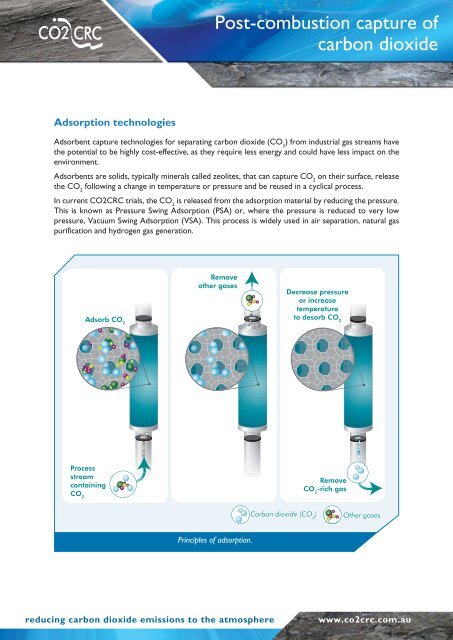
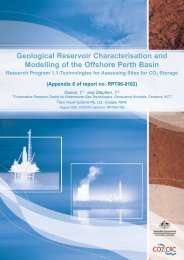
![Post-combustion solvent absorption [PDF 438KB] - CO2CRC](https://img.yumpu.com/48575763/1/184x260/post-combustion-solvent-absorption-pdf-438kb-co2crc.jpg?quality=85)

